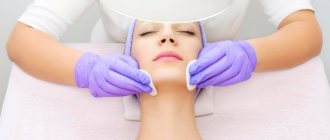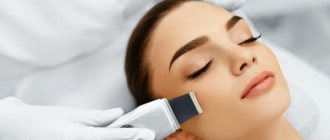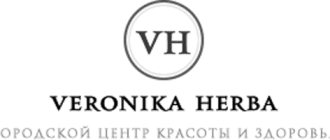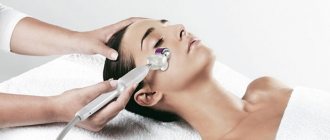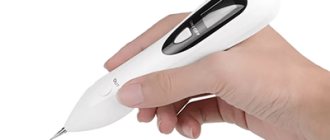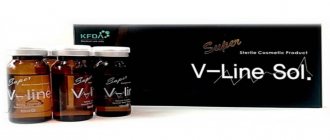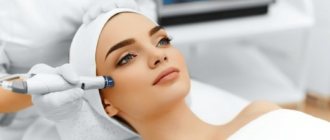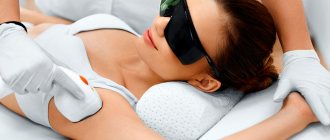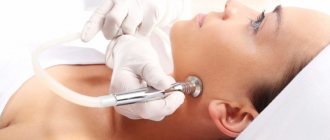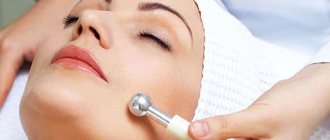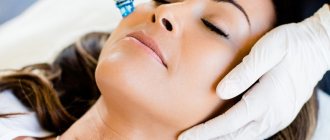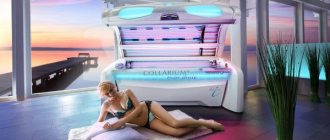Problem skin is a serious aesthetic drawback. Fortunately, modern cosmetology has methods that help cope with enlarged pores, scars and the consequences of acne, wrinkles, and relief disorders. One of the most effective methods is laser facial cleansing. Of the devices used for this procedure, the neodymium laser is highly effective and safe to use.
What is laser cleaning?
Unlike chemical procedures, the list of side effects and possible negative consequences of laser cleaning is minimal. It is painless when performed correctly and with high quality, non-traumatic, harmless to the body as a whole, and copes even with old cosmetic defects.
The essence of the cosmetic procedure is the effect of a laser beam on the epidermis, which is emitted by a special device. Under the influence of the beam, the upper layer of the epidermis evaporates, and the cells underneath begin to actively divide to fill the space. The cosmetologist acts on the upper layers of the epidermis, after which the skin becomes elastic and radiant, pigmentation is removed, scars and post-acne scars, and fine wrinkles become less noticeable. This cleaning is carried out under local anesthesia, but if you have a high pain threshold and your facial skin is not very sensitive, then you will not need painkillers.
Lasers have been successfully used in medicine for several decades. Laser therapy is indicated for furunculosis and hidradenitis, adenoids, psoriasis, and immunodeficiency conditions. Ultraviolet and infrared light produced by the device inhibits pathogenic microbes and fungi, improves blood circulation, and stimulates the immune system.
The laser cleaning device not only performs the function of polishing, it is also used for laser hair removal.
The most common devices include: American CO2 Ultrapulse, German Erbium laser MCL-30 Dermablate, German Erbium laser Dermablate Effect, Korean Fractional CO2 laser Mixel. The wavelength is usually 10600 nm.
Dry cleaning
In this type of procedure, a special product (peeling) based on fruit, salicylic or glycolic acid is applied to the face. It dissolves sebaceous plugs, removes dead skin and tightens pores. Afterwards, a gel is applied to the skin, the face is massaged to form granules that will finally remove small scales, and only then a face mask is applied. Each drug is selected individually by a cosmetologist for a person’s specific skin type in order to avoid a possible allergic reaction to certain components.
Advantages and disadvantages
The advantages of the procedure include:
- slowing down the aging process of the epidermis;
- smoothing skin texture;
- narrowing of pores;
- improvement of complexion.
Disadvantages of the method:
- pricing policy, especially considering that laser cleaning needs to be done not just once, but in a course;
- presence of contraindications;
- pain and the need for local anesthesia in people with a low pain threshold and sensitive skin;
- rehabilitation period, which can last up to 2 weeks.
Laser facial cleansing is called resurfacing, because after the laser the skin becomes smoother and more elastic, the relief is evened out.
Algorithm
Laser cleaning usually takes no more than half an hour. The procedure begins with makeup removal, then the skin is treated with an antiseptic composition, and the patient is asked to put on safety glasses. If necessary, problem areas are treated with a local anesthetic. The main part of the impact is laser treatment. Smoothly, section by section, the skin is exposed to light pulses.
The patient needs to control his sensations, because based on them, the cosmetologist will be able to adjust the settings of the device to obtain optimal results. In case of painful sensations, the length of the beam is reduced, in the complete absence of any effect, it is increased. At the end of the procedure, the skin is treated with a moisturizing and regenerating cream.
Indications and contraindications
Laser peeling is indicated in the following cases:
- post-acne – dark spots, acne scars;
- loss of skin elasticity;
- black dots;
- uneven relief of the epidermis;
- small shallow wrinkles;
- dark spots;
- dull skin color;
- freckles.
You should not go to a beauty salon for a laser resurfacing procedure when you have:
- there are inflammatory elements on the skin, wounds and ulcers;
- chronic diseases have worsened;
- acne recurrence;
- if the epidermis is prone to the formation of keloid scars;
- hormonal imbalances;
- epilepsy and other serious diseases of the central nervous system;
- pathologies of the cardiovascular system.
Laser resurfacing cannot be done in the summer, otherwise you risk developing pigmentation.
Atraumatic cleaning
Atraumatic cleaning is also called superficial aesthetic peeling. It is suitable for any skin type. The procedure takes place in several stages. At first, the skin is cleaned of impurities, then a drug is applied to the epidermis to expand the pores. The cosmetologist performs peeling using fruit acids in a certain proportion for each client individually, depending on skin type. After this, herbal lotion and mask are applied to the face. And the final step is a cream suitable for a specific skin type. This procedure lasts about an hour, after which it is not recommended to visit a solarium, bathhouse or sauna, and it is also recommended to apply protective medications for another two to three days. In our clinic, the atraumatic cleansing procedure is carried out using Israeli Holy Land cosmetics.
Procedure
There are two types of laser resurfacing:
- Deep, it is compared to second degree burns. The rehabilitation period lasts for two weeks, requires careful care and can cause serious side effects. A painful procedure that requires anesthesia.
- Superficial. Only the upper layer of the epidermis is affected, the recovery period is easier and faster, but can only solve mild cosmetic problems.
If you decide to have laser facial cleansing, then you need to follow a few simple rules during the preparatory period:
- do not visit the solarium and the beach two weeks before the procedure;
- you cannot carry out other types of facial cleansing, steam the skin, make masks and scrubs;
- You should not drink alcohol, attend workouts or go to the pool a few days before the procedure.
When you come to a beauty salon for laser facial cleansing, the master will first cleanse your skin and remove makeup. Hair is tucked under a bathing cap. The skin will be treated with an antiseptic solution and, if necessary, an anesthetic – gel with lidocaine. Special glasses are put on the eyes so as not to accidentally injure the eyes. Half an hour later, after the anesthetic has taken effect, the device will be adjusted to the desired frequency, calibration will be tried on a small area and they will begin to work on the face for 30-60 minutes, depending on the type of cleaning. In some beauty salons, before the procedure, a special mask is applied to the face and cling film is applied to maximally steam the skin and open the pores. The laser seems to “shoot” at your skin. Each such flash is accompanied by a loud bang and a burning smell. This does burn off some of the skin; there will be a smoke vent in the office next to your couch to eliminate this unpleasant odor. During deep laser resurfacing, people with sensitive skin and a low pain threshold will experience pain, especially in already burned areas. If the cheeks or the entire face are being treated, ice may be applied to the treated areas of the epidermis.
When all areas have been treated, anti-burn cream will be applied to the face. The skin will turn red and there will be a burning sensation and pain. It's better to get home by car. In order not to scare others with your flaming face, the salon will give you a gauze medical bandage and advise you to wear dark glasses.
Possible negative consequences of laser resurfacing include:
- pigmentation;
- exacerbation of acne;
- edema;
- skin infection;
- severe psychological stress;
- erythema.
The recovery period takes several days with proper care. It is better to stay at home for a week so as not to infect your skin, not use cosmetics and avoid exposure to the sun. On the first day you need the most thorough skin care, so laser resurfacing is best done in the morning. After the salon, the face should be treated with chlorhexidine wipes and smeared with Panthenol. You can take painkillers and antihistamines. The main thing is to be mentally prepared for the fact that ichor will periodically appear on the skin, and the face will burn and swell for the first day. On the second day it will become much easier. Constantly lubricate the skin with Panthenol and treat with chlorhexidine. If you did deep grinding, the recovery time is up to 8-9 days. Two to three days after the procedure, the redness will be replaced by brown crusts that will fall off. Underneath there will be new skin, smoother and more uniform.
During the recovery period, the following tools will be useful to you:
- Panthenol or any good cream for burns (milk or foam Panthenol, Dexapanthenol, Bepanten-Plus);
- antiseptic liquid for treating hands when caring for facial skin (everything must be sterile);
- Methyluracil ointment (helps cope with crusts and acne that occur after frequent use of fatty Panthenol)
- Saline solution, which can be used to wash your face a couple of days after the procedure;
- Solcoseryl gel for healing.
Deep laser resurfacing of the face can be done no more often than once every 9 months. The interval between surface cleanings may not exceed 30 days.
The video shows a review of laser resurfacing by one of the popular beauty bloggers.
Mechanical cleaning
Indications for it are severe sebaceous glands, an increased number of comedones or acne, and a tendency to frequent inflammation. It is done manually, without machines. First, the face is steamed using hot compresses or special masks. Then the cosmetologist treats the skin with antiseptics and squeezes out the contents of the pores one by one using special metal spoons. This is the method recommended for people with oily and problematic skin. After cleansing, the face is disinfected with an anti-inflammatory composition. The whole process takes from one to one and a half hours. After the procedure, it is recommended not to use decorative cosmetics and not sunbathe for 4-5 days.
Photos before and after the procedure
Types of cleanings and who they are suitable for
Gone are the days when care consisted of steaming the dermis, squeezing out pimples and applying primitive compositions for masks. Cosmetology does not stand still, and therefore today this area amazes with the variety of procedures performed. Among the main types are:
- mechanical;
- chemical;
- ultrasonic;
- vacuum;
- laser;
- disincrustation.
Each of the listed techniques should be carried out in a salon setting, and before the session, be sure to consult a doctor. It is he who, based on the condition of the patient’s epithelium, age, characteristics, existing problems, will tell you what type of procedure will be required. Although all methods have a common goal - cleansing, they differ from each other in the method of implementation, the devices or compositions used, and indications.
So, they are recommended for people with the following problems:
- black dots;
- acne;
- acne;
- impaired secretion of the sebaceous glands;
- loss of turgor;
- deterioration of dermis tone;
- lethargy, aging.
After cleaning by a cosmetologist, as the photos show, the face is noticeably transformed: the color becomes healthy, the epidermis becomes elastic, clean, pores narrow, comedones are eliminated, and there is no trace of fine wrinkles.
Is it possible to do laser facial resurfacing during pregnancy and lactation?
Laser resurfacing is stressful. The laser itself does not have a negative effect on the fetus, however, during pregnancy a woman is vulnerable both physically and mentally. If in normal times it is known how the body will behave and react to the laser peeling procedure, then during pregnancy and lactation unexpected negative consequences may occur. Therefore, you should not take risks; postpone this cosmetic procedure when the baby is already born and will do without your breast.
Deep cleaning
In our salon you can undergo a unique Holy Land deep atraumatic skin cleansing procedure. This is not just cleansing, but a whole range of professional facial care. Here, your skin will first be superficially cleaned, then a special softening gel will be applied. It will literally dissolve the contents of the pores, which will allow you to do without steaming. Next, the pores opened by the gel will be additionally cleaned with a special cosmetic item - a Uno spoon. Additional peelings and solutions that will be used during cleansing also moisturize the skin and help normalize the functioning of the sebaceous glands. This method is especially effective for people at an age when the skin is already beginning to fade. But the contraindications for it are the same as for facial cleansing in general: eczema, skin diseases, acne in the inflammatory stage.
